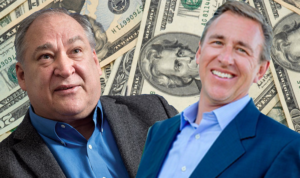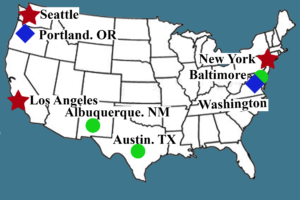Public Funding Gets a Winner!
Washington – When it comes to the influence of political money on our election campaigns, you know the bad news, but you probably don’t know the good news – or even that there is good news.
The bad news is that billionaires and corporations are pouring tons of money into our elections to buy influence in Washington and in your state capital. The good news is that some states and local areas are using public funding of campaigns to empower small donors and to keep the Mega-Money campaign donors from drowning out the voices of average voters.
Already, in this year’s election cycle, the good news is that Public Funding has scored a big victory. More on that in a minute. But first, most people forget that for a couple of decades, the U.S. used public funding in our presidential campaigns.
Four Presidents Used Public Funding
So for six election cycles, presidents from Jimmy Carter and Ronald Reagan to George Herbert Walker Bush and Bill Clinton received public funding to match the private donations they raised. The program was funded by millions of taxpayers making small donations through check-offs on their tax returns.
 To pass muster with the U.S. Supreme Court, it had to be a voluntary program. To qualify for public funds, Presidents Carter, Reagan, Bush, Clinton and their opponents had to accept spending limits on their campaigns. That was the critical deal. It prevented an orgy of campaign fund-raising and spending.
To pass muster with the U.S. Supreme Court, it had to be a voluntary program. To qualify for public funds, Presidents Carter, Reagan, Bush, Clinton and their opponents had to accept spending limits on their campaigns. That was the critical deal. It prevented an orgy of campaign fund-raising and spending.
But eventually, presidential campaigns got ridiculously expensive and fewer taxpayers kicked in, and so the public funding system broke down at the presidential level. Presidents George W. Bush and Barack Obama opted out.
Four States Have Robust Public Funding
Fortunately, the states stepped in and so today we have 25 states with some form of public funding for campaigns. Four states – Arizona, Connecticut, Maine and Minnesota – have robust systems that offer public funding to candidates for major state offices like governor, Lieutenant governor, attorney general and for people running for the state legislature.
Like the federal program, these state programs are voluntary and they get heavy participation from candidates from both major parties, Republicans and Democrats, and smaller parties, too. In Connecticut, for example, in the last statewide election, all the general election candidates for major office used public funding and so did 80% of the candidates for the legislature.
Some other states – Maryland and half a dozen others – just fund candidates for the top state offices, governor and lieutenant governor. In fact, the current governor of Maryland, Republican Larry Hogan, won the last gubernatorial race using public funds against a better funded, privately funded Democratic opponent.
A Shot in the Arm for Public Funding
 Public funding in Maryland just got another shot in the arm from Montgomery County, a suburb of Washington, DC, that has more population than six states (Alaska, Delaware, North Dakota, south Dakota, Vermont and Wyoming) when a publicly funded candidate defeated a wealthy businessman funding his own campaign for the top elected post in the county.
Public funding in Maryland just got another shot in the arm from Montgomery County, a suburb of Washington, DC, that has more population than six states (Alaska, Delaware, North Dakota, south Dakota, Vermont and Wyoming) when a publicly funded candidate defeated a wealthy businessman funding his own campaign for the top elected post in the county.
What Montgomery County does in its brand new public funding program is to provide a 6-to-1 match for small donations up to $150 – six public dollars for every private dollar contributed by small donors. So every small donation of $150 quickly becomes worth more than $1,000 to a candidate. That’s a big incentive for candidates to sign up voluntarily for public funding.

Publically Funded Candidate Marc Elrich beats businessman David Blair who funded his own campaign in Montgomery County MD.
This year, in the big race for the Democratic nomination for the top job of County Executive, Mark Elrich, a county council member who got half a million dollars in public funds, beat out businessman David Blair who spent $3 million of his own money. The race was so close that it took two weeks for election officials to finish the vote count with Elrich winning by 80 votes.
Public funding figured prominently in other races, too. The Republican nomination was won by Robin Ficker, who qualified for public funding. And five of the nine candidates who won Democratic nominations for county council were publicly funded.
Where Else Is Public Funding in Play?
Going into this fall’s election, public funding systems will be in play in a total of 25 states, mostly for judicial races. For a state-by-state rundown. Check out http://reclaimtheamericandream.org/progress-public
 Major cities like New York, Los Angeles and Seattle. have become hubs for public funding of local elections. Two other cities, Portland, Oregon and Washington DC, have recently adopted public funding for future elections. And there is a push for public funding of local election campaigns in cities from Baltimore, Md., to Austin, Texas, to Albuquerque, New Mexico.
Major cities like New York, Los Angeles and Seattle. have become hubs for public funding of local elections. Two other cities, Portland, Oregon and Washington DC, have recently adopted public funding for future elections. And there is a push for public funding of local election campaigns in cities from Baltimore, Md., to Austin, Texas, to Albuquerque, New Mexico.
So stay tuned. Pubic funding offers a growing alternative to voters’ letting billionaire and corporate campaign donors capture American elections, mostly operating through dark money. Public funding brings political money out in the open, where we can all see what’s going on.



 Hedrick Smith, who conceived this website and is its principal writer and architect, is a Pulitzer Prize-winning former New York Times reporter and Emmy award-winning documentary producer for PBS and PBS FRONTLINE.
Hedrick Smith, who conceived this website and is its principal writer and architect, is a Pulitzer Prize-winning former New York Times reporter and Emmy award-winning documentary producer for PBS and PBS FRONTLINE. 


